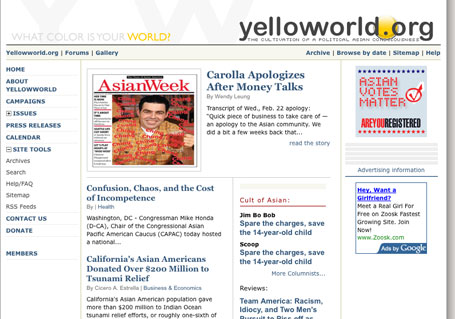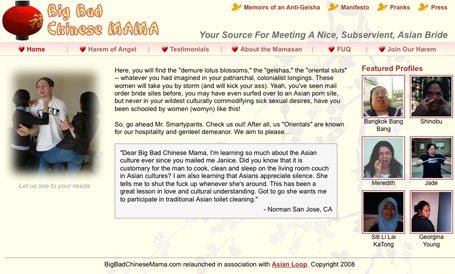During the dot-com boom of the late 1990s and pre-bust aughts most websites focused on creating flashy, interactive homepages whose main purpose was to hide what wasn’t inside. The ploy often succeeded brilliantly, drawing millions in venture dollars to loopy concepts that fizzled in the real world.
From the beginning Goldsea impressed no one except readers seeking intelligent Asian American perspectives. It was backed by not a single dollar of venture capital, only Kagy’s dozen years of hard experience publishing magazines for Asian Americans. Its staff naturally felt threatened by venture-funded Click2Asia and its high-profile promotional blitz.
“They’re spending so much money — aren’t you worried?” one staffer asked.
“No,” said Kagy, “because it isn’t my money.” The rueful bid at humor referred to the millions bled during his first years as a magazine publisher.
He saw competing Asian American publishers as more of a boost than a threat because they shared the heavy lifting of educating advertisers about the Asian American population. And the size of a venture’s funding had ceased to impress him years ago. Since 1986 when he launched AsiAm he had seen many well-financed competitors come and go, some of which had much deeper pockets than newcomer Click2Asia.
In the late 1980s a Time Inc subsidiary spent several years developing an English-language magazine to serve the pan-Asian market which had first come into vogue then, partly because of the attention generated by AsiAm and Rice. After spending many millions, Time pulled the plug without publishing a single issue.
In 1996 cable giant Comcast had launched AZN TV through its International Networks subsidiary. AZN aired an impressive array of English-language programs including Asian films, dramas, documentaries, anime, music videos and even some original shows. It also sponsored the Asian Excellence Awards for a half dozen years in partnership with A Magazine. But ad sales didn’t generate the scale of revenues needed to sustain its corporate-scale operations, forcing the venture to cut back drastically in 2005. In April 2008 Comcast decided that AZN’s prospective P&L didn’t make sense, especially in a recession, and took it off the air.

AsianWeek began as a tabloid distributed in and around San Francisco’s Chinatown. It published for over a quarter century before stopping the presses in 2009. It continued online publication for some time afterward thanks to the efforts of volunteers.
Media conglomerates weren’t likely to become a major force in Asian American media and consciousness, Kagy had concluded. Unlike the mass media, Asian American media was only viable if founded on a core of personal commitment. Only someone who had grown up Asian in America, had experienced professional life in the mainstream and had an unusual depth of verbal skills could grasp and articulate the common sensibilities of a population otherwise fragmented by a wild diversity of national origins and cultures. And Asian Americans harbored distrust toward media giants as the fountainhead of hated stereotyping. That distrust could only be overcome by more years of money-losing sacrifice than corporate beancounters could ever allow.
The only media that Kagy himself saw as credible rivals — albeit friendly ones — were those fueled by the same heartfelt commitment he had poured into his magazines and websites.
One was Asianweek, a San Francisco-Bay area tabloid with an online presence. It was founded in 1979 and run as a family business out of a Chinatown shopfront. For over a quarter century the family dropped off free stacks of the English-language weekly in Bay Area restaurants and stores. In the 1990s control was inherited by the Fang sons when the founder died. They added some polish to the paper but it retained its grassroots focus and feel. In the early 2000s Asianweek saw the writing on the wall and belatedly struggled to build its online presence. Its online editor sought and received permission to rerun some Goldsea articles. By the end of 2008 Asianweek was battered by the recession and couldn’t continue sending its papers to press. Its online edition was kept alive for some time afterward by columns contributed by volunteer.

Yellowworld.org was founded in reaction against Goldsea’s policy of editing reader posts for hate, obscenity, libel and porn. During the forum era it enjoyed considerable traffic from young Asian Americans testing the limits of uncontrolled free expression.
Another homegrown Asian American medium was ImaginAsian Television (iaTV). It was founded in 2003 out of a New Jersey warehouse by Korean American Michael Hong, a former Nielsen Media Research exec who had grown up in a largely Asian Queens neighborhood. Its staff of four struggled to provide programming for a pan-Asian population with shows imported from every corner of Asia. They were later augmented by an original Asian American talk show. By 2007 Hong signed carriage deals with major cable companies and even attracted several big-name advertisers. But the recession that began in December of 2007 kept advertising revenues below costs, forcing iaTV to go off the air in late 2009.
Not all Asian American sites aimed to become commercially viable. Some were driven purely by the desire to vent. Among the more visible was YellowWorld.org, founded in May of 2002, partly in reaction to Goldsea’s policy of censoring reader posts for hate, obscenity, libel and porn. For several years Yellowworld enjoyed surprising levels of traffic from young Asian Americans eager to push the limits of their newfound freedom of expression. With the passing of the forum era in the mid 2000s, much of Yellowworld’s audience moved on.
The tide of Asian American voices that rose in the early 2000s were augmented by single-person blogs like BigBadChineseMama.com (founded in February of 2000) and AngryAsianMan.com (April, 2002). Others were launched by academics seeking to share scholarly information on Asian Americans, including AsianNation.org and ModelMinority.org. Countless others peopled blog sites like Xanga and Blogspot. Clearly, Asian Americans had much to say and were increasingly seeking out space in which to say it without unwelcome intrusion. From this explosion of voices emerged a picture of Asian Americans as a population of individuals with widely divergent styles and viewpoints. It was a welcome release from three generations of racial stereotyping. Yet the one theme that continued to run through these many Asian voices was the persistent misunderstanding and mischaracterization to which they felt subjected by American society and media.

BigBadChineseMama is one of the more popular Asian American blogs that started up during the aughts. It takes a militantly satiric tone toward stereotypes of Asian women as submissive sexual toys.
Goldsea went through its own evolution. By the time the dot-com madness peaked with a wildly overinflated AOL buying venerable media giant Time-Warner in the spring of 2002, Kagy had learned that the internet demanded a new approach to publishing. Gone were the time and space limitation of magazines. Added was the capability to archive articles that chronicled the lasting achievements of Asian Americans. The concept of issues and press deadlines, which had driven his life and thinking for a dozen years, had become meaningless. The change freed him from the tyranny of the calendar and imposed the more demanding tyranny of the clock. Website visitors expected to see something new every day, even two or three times a day. Yet the core mission of an Asian American site remained the same: sharing the most deeply felt Asian American experiences and triumphs. Kagy’s solution was to structure Goldsea as part daily and part archive.
Another aspect of Goldsea’s evolution was driven by the expansion of the Asian American consciousness in a world shrunken by the internet. No other American population segment had suffered so much direct impact from events and developments overseas. World War 2, the Korean War and the Vietnam War had filled the American media with images that translated into mistrust, hatred and violence toward Asian Americans. During the 1980s Japan’s success at building efficient, economical cars had triggered Asian-bashing like the cowardly swinging of a baseball bat at Vincent Chin’s skull by laid-off auto workers. In the 1990s China’s emergence as a military and manufacturing power had incited a new wave of American xenophobia, poisoning the air for Asian Americans and subjecting people like physicist Wen-Ho Lee to witch-hunt persecution.
Asian Americans also benefited from positive images that blew across the Pacific. In the 1970s Hong Kong films became a source of pride and positive identification for young Asian Americans with the introduction of stars like Bruce Lee, Jackie Chan and Gong Li. In the 1990s Japanese anime culture let young Americans share a fun, race-neutral universe. In the aughts the Korean Wave of movies and music washed away MASH-era images of Asians as pathetically unstylish people living in impoverished conditions.
Given the longtime dearth of Asian images in the American media, the images coming out of Asia were having a far bigger impact on the American consciousness than homegrown ones. Educated Asian Americans increasingly looked to developments on the other side of the Pacific for the changes we could expect in American perceptions of Asians. Asia’s powerful influence on how Americans saw us had been a key theme of Transpacific magazine. Now the internet made it possible for Goldsea to present daily the significant developments in various Asian nations that were likely to set the tone for Asian Americans.
One reality that remained unchanged through the turmoil of the internet’s first decade was that survival depended on advertising. The dot-com boom had turned the media landscape upside down. The madness is best illustrated by AOL’s buyout of Time-Warner in January of 2000, just before the dot-com bubble began deflating. Barely-profitable AOL, with revenues of only $4.8 billion, was able to use its inflated valuation of upwards of $186 bil. to buy control over 77-year-old media colossus Time Warner with revenues of $26.8 bil. That madness took almost exactly a decade to unwind. In December of 2009 Time Warner cut loose the stinking albatross that AOL had become in a $2.5 bil. spinoff, signaling the restoration of some sanity in the media world.
By then the Great Recession was decimating advertising. A 40% ad revenue drop was putting Time Warner deeply into the red. Even The New York Times was forced to borrow $250 million from Mexican telecom billionaire Carlos Slim who already owned 7% of the paper. The loan fueled speculation that the Sulzberger family would soon have to sell out to Slim.
In the scramble for survival Asian American sites like Click2Asia and AsianAvenue found salvation by giving up ambitions of becoming Asian American portals and focusing on the Asian singles/dating space, leaving Goldsea and its sister sites as the sole remaining pan-Asian American content sites. And everyone seeking to learn about anything Asian American — from super-achievers to supermarkets, from Joan Chen to Gary Locke, from selling out to Asian American parenting — inevitably seem to find themselves on Goldsea’s pages. Something tells me that isn’t likely to change for another quarter century or two.
Read Part 1 | Part 2 | Part 3 | Part 4

